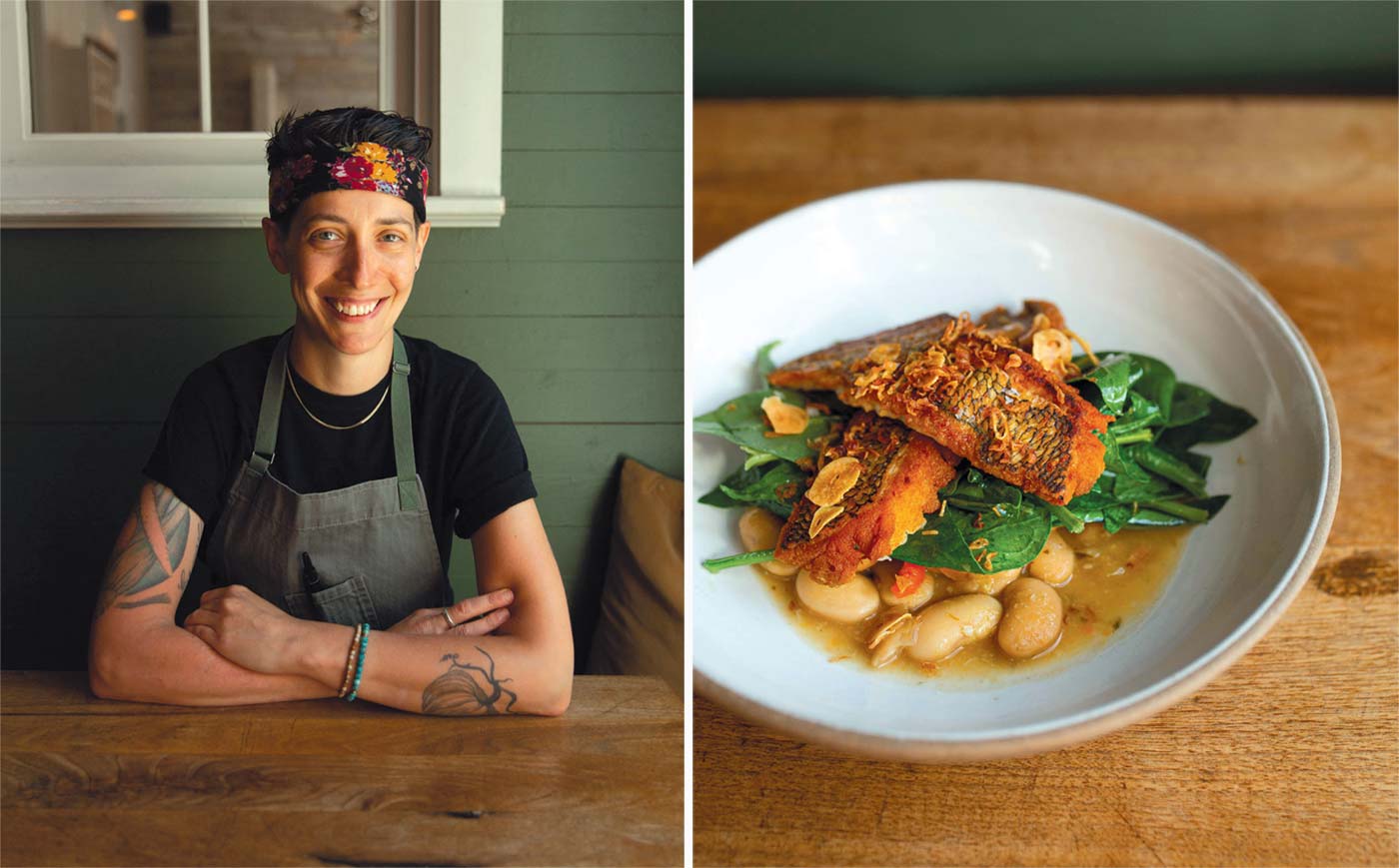Butchering the Whole Fish
The Oyster Club in Mystic is a long-time favorite restaurant for many locals and visitors alike, in business for over ten years and enjoying many accolades under former Executive Chef James Wayman. Chef Renee Touponce joined the team in July 2017 and in the last year became the Executive Chef, instilling her own inimitable style and approach. And the restaurant itself has undergone a wonderful physical transformation as well. It feels more spacious as the previously sequestered kitchen is now fully open to diners and features an opportunity to sit up close as the shuckers do their thing while the cooks do their magic in the background.
When you meet her, you know right away that Chef Renee Touponce is a special human. She is confident yet warm, approachable, and considerate. And clearly passionate about the flavors she is creating, the team she works with, and the community itself.
Most recently, Renee was the executive chef at Firebox in Hartford. But there came a time when she and her partner, Jade Ayala, started thinking about making a change. After meeting with 85th Day Group CEO Dan Meiser and Chef James, Renee quickly realized the broad opportunity available in Mystic and agreed to step back from being an executive chef to starting as a line cook and working alongside James and the many other talented cooks in the kitchen. Jade also joined Oyster Club and now spearheads the bar program at Oyster Club, so they’re working together again as at Firebox.
“Here at Oyster Club, we're all about supporting our local farmers and fishermen and the community that we're surrounded by. Keeping those connections that have always been here that were created before me. It's really awesome to still have that. And that is a huge part of what we still do and continue to do.”
The Mystic area really is a special location for local connections. There is a wealth of farms, produce, and meat throughout the Connecticut River Valley and through the eastern part of Connecticut. But there is also the bounty of the ocean and The Sound literally out the door of the restaurant.
“It seems like Mystic is the new New York.”
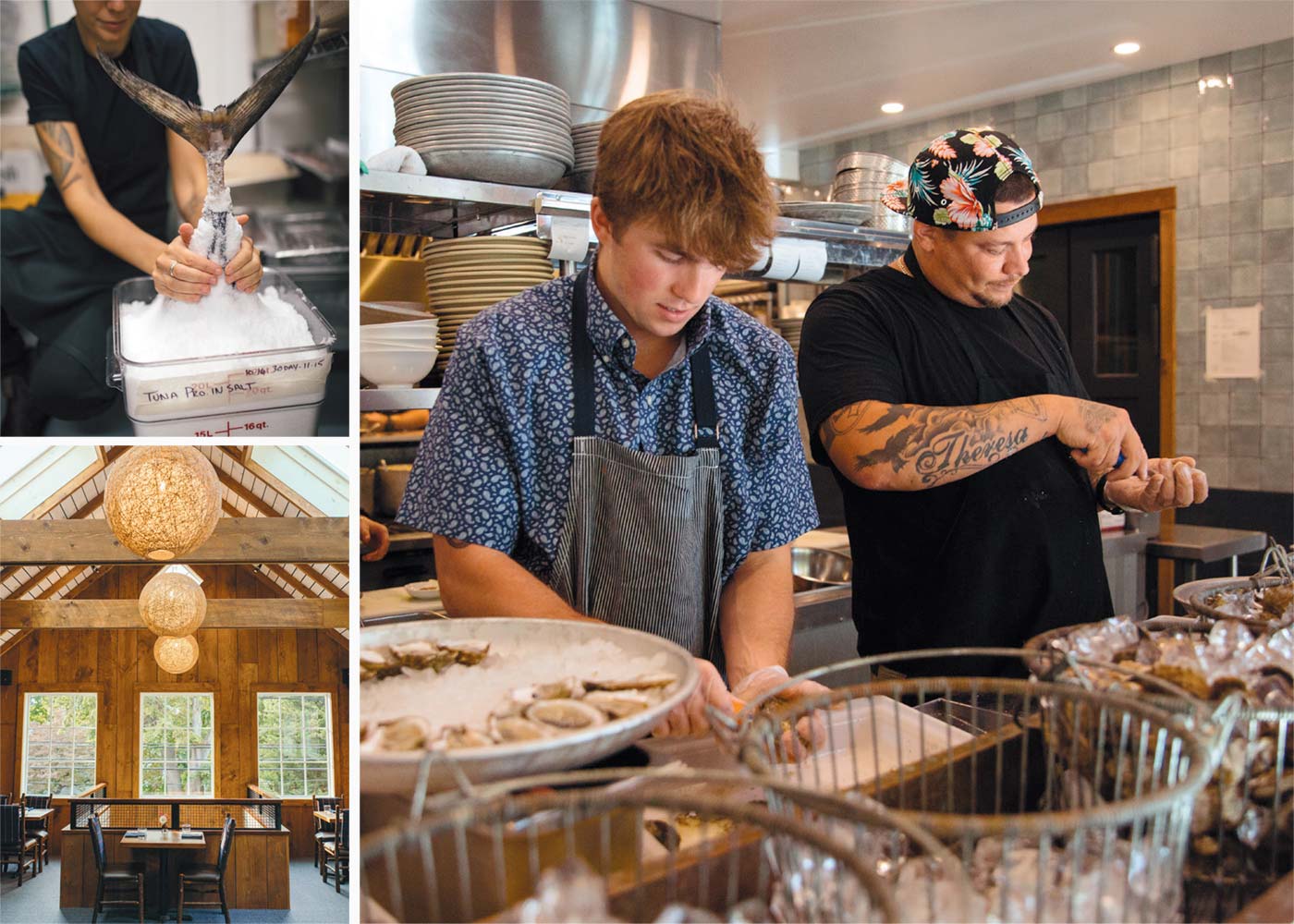
(top left) Chef curing the tuna tail; (bottom left) a view of the dining room; (right) happy oyster suckers!
“We work with Alene Whipple of SeaWell Seafood as well as directly with local fishermen. One of our guys is the famous Vinny and he goes out and will catch whole tuna and whole swordfish. He'll call me and let me know, ‘I just caught all this. Do you want it?’ And I'm like, yes, absolutely. And then next thing you know, it's in my Yeti!”
Working with the whole animal is not what every Chef does. There are many who do of course, but Renee takes it to the next level. Using every part of the fish, creating tuna ham and sausage, for example, is really pretty extraordinary. “We're getting this whole fish and it's really amazing to be able to break the whole thing down. To be able to teach my cooks and butcher how to break down a whole fish, utilizing all the scrap, all the waste, making stock with the bones, also working with the head, the same way you would with a pig or a cow.”
Renee has a lot of experience butchering pigs and cows, as well as the world of making use of the whole animal, for head cheese, charcuterie, liver mouse, and pates. She is clearly applying those approaches and techniques, in her own unique way, to her whole fish butchery.
She brings an almost childlike curiosity to the process that is infectious. “I’m like, why can't I do that? Why aren't we doing that? I've been taking the tail end of tuna and turning that into prosciutto, or ham essentially. Typically, the end is more fibrous near the tail and many people would take that and just grind it for tuna burgers or something like that, because it's not the nice loin or the nice eye of the tuna.”
“So, I've been preserving tuna, salting, curing, and dry aging the same way you would make prosciutto. We cure the fish so that you can slice it and serve it over top of vegetables or over top of pasta, or just as on its own, the same way you would use any cured meat. Another thing I've been making is tuna chorizo, which has been really popular. I take all the scrap from the swordfish, and I make a mortadella with it. I take the monkfish livers and make a mousse with them and for this area, it's not very common. I'm excited to explore that more and really show that on our menu and be able to teach the community about the new flavors.”
Yet Chef still brings a lot more of herself to the mix. Coming from a family of Italians and Puerto Ricans she adds a large dash of multicultural influence to her cooking as well. “My mom is Italian, and my stepfather is Puerto Rican. Those foods and flavors definitely influenced me and now it's just happening organically in my cooking. When I'm creating food or dishes, I'm throwing in all these ingredients like sofrito or adobo or even just really delicious basil and tomatoes and interchanging those two together.” It seems to be a totally natural thing for Renee versus something she consciously thinks about doing. “I'm starting to create more comfort food like empanadas, bacalaitos, rice and beans, pasta, and having all those spices that are just happening naturally.”
Oyster Club has always strived for an inclusive and happy kitchen, something Renee obviously endorses and finds refreshing and inspiring. “Being in a kitchen surrounded by such amazing cooks that are from all parts of the world definitely helps. I like to have them as involved as much as possible with the food too. We have people here from Peru, Chile, Ecuador, and Vermont. Being able to talk to them and have them be excited about the food and teaching me while I'm teaching them is fantastic! They say, ‘Try this ceviche or try my delicious sauce.’ And I love that. I love that. I love that so much.”
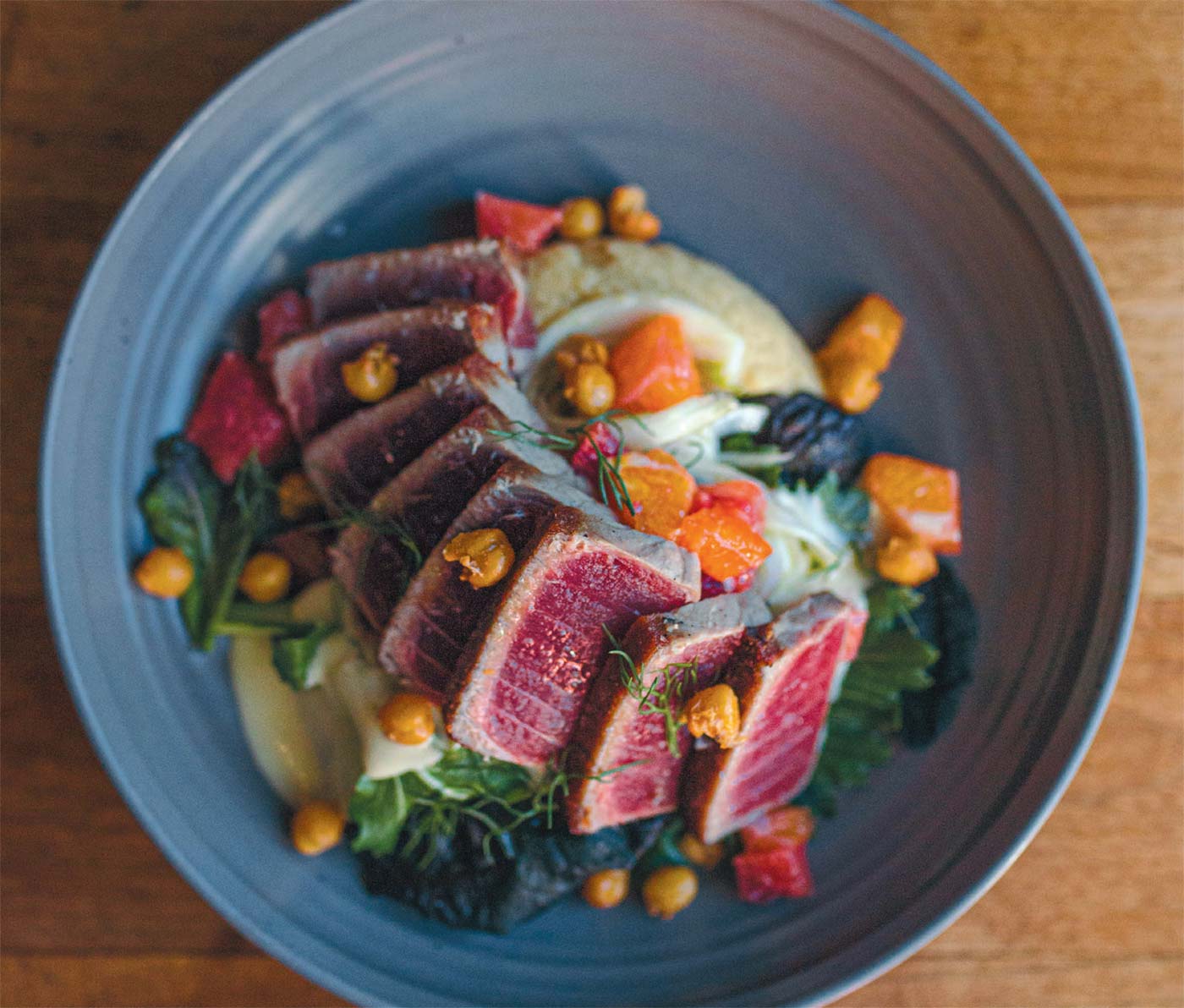
Bluefin tuna, grilled radicchio, fennel, blood orange, chickpea & lemon tahini
“I definitely don't take it for granted. I have a really great team behind me that works very hard for me and are extremely talented and I'm very lucky and it's not just me. It's definitely us. Yeah.”
When hiring new staff Renee’s personality really comes through. Her caring and considerate approach is, we think, fairly unique. In fact, we were quite touched when we asked what she looks for in new kitchen staff. “Oh gosh. For my team here, I think that it's super important that, my first and foremost desire is that they're kind and that they're humble. I think in the chef world, we definitely get caught up in our own egos. We all want to do well in our worlds, but I think having really passionate, dedicated kind, real people is extremely invaluable. What can they bring to the table in the sense of their passions and are they going to work really hard? When you have people like that, you can take the time to teach them and show them. I've had a lot of that. I'm very thankful for that opportunity to teach people.”
We wondered what was in store for lucky diners over the winter. One of the beautiful things about our region is the very distinct change of seasons. Renee sounded excited, “I'm definitely looking forward to using all the preserves that we make throughout the summer. We definitely preserve all the peppers, fruits, tomatoes, and make lots of vinegars. Now we’re preserving all the tuna and making ham. Over the winter we still have all that available to us in our pantry, like drying out all of our chilies. And I'm a fan of root vegetables. I know we're always like, ah, here come the root vegetables and nobody really gets excited. But I like the shift in seasons and making things warmer and a bit cozier.”
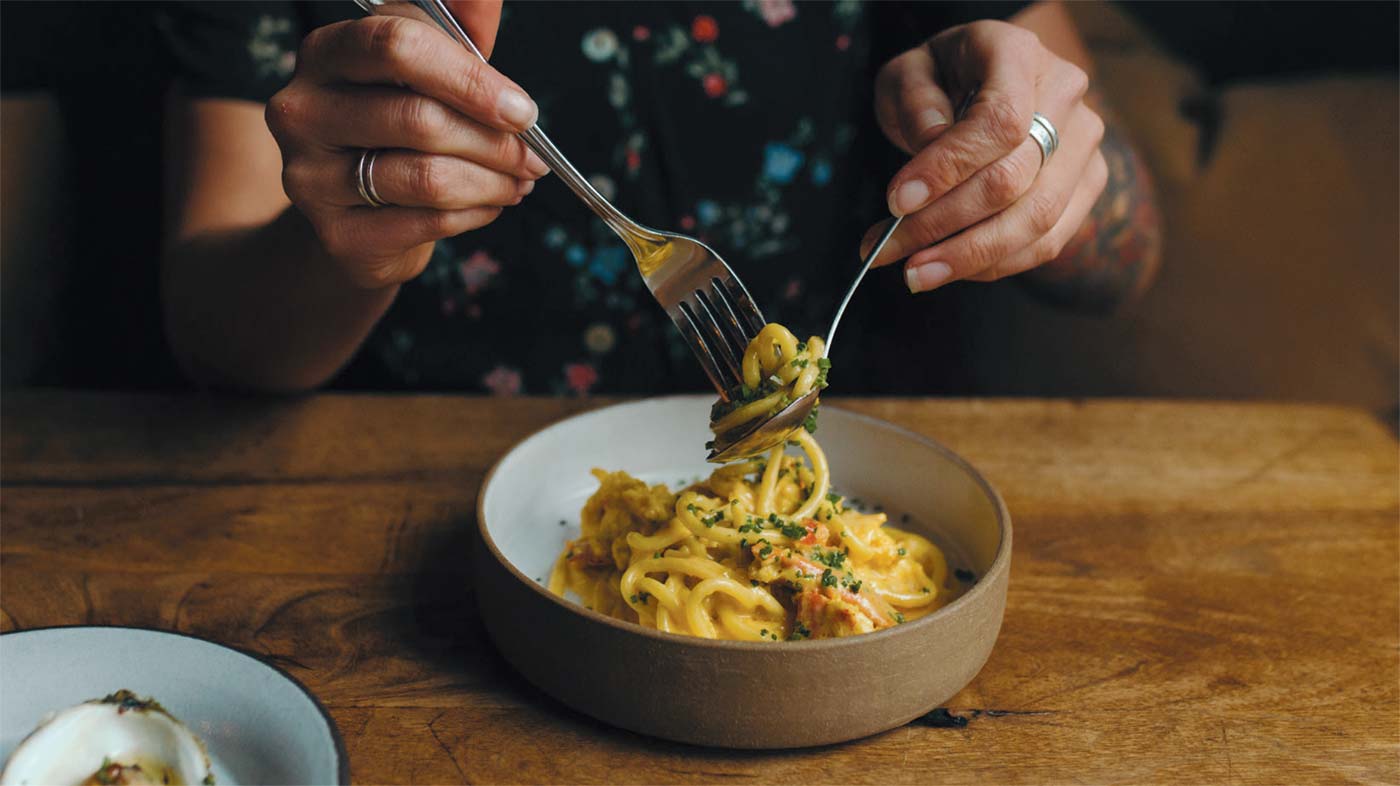
House made bucatini pasta, hand picked local lobster, sea urchin butter & chives; Renee in the open kitchen
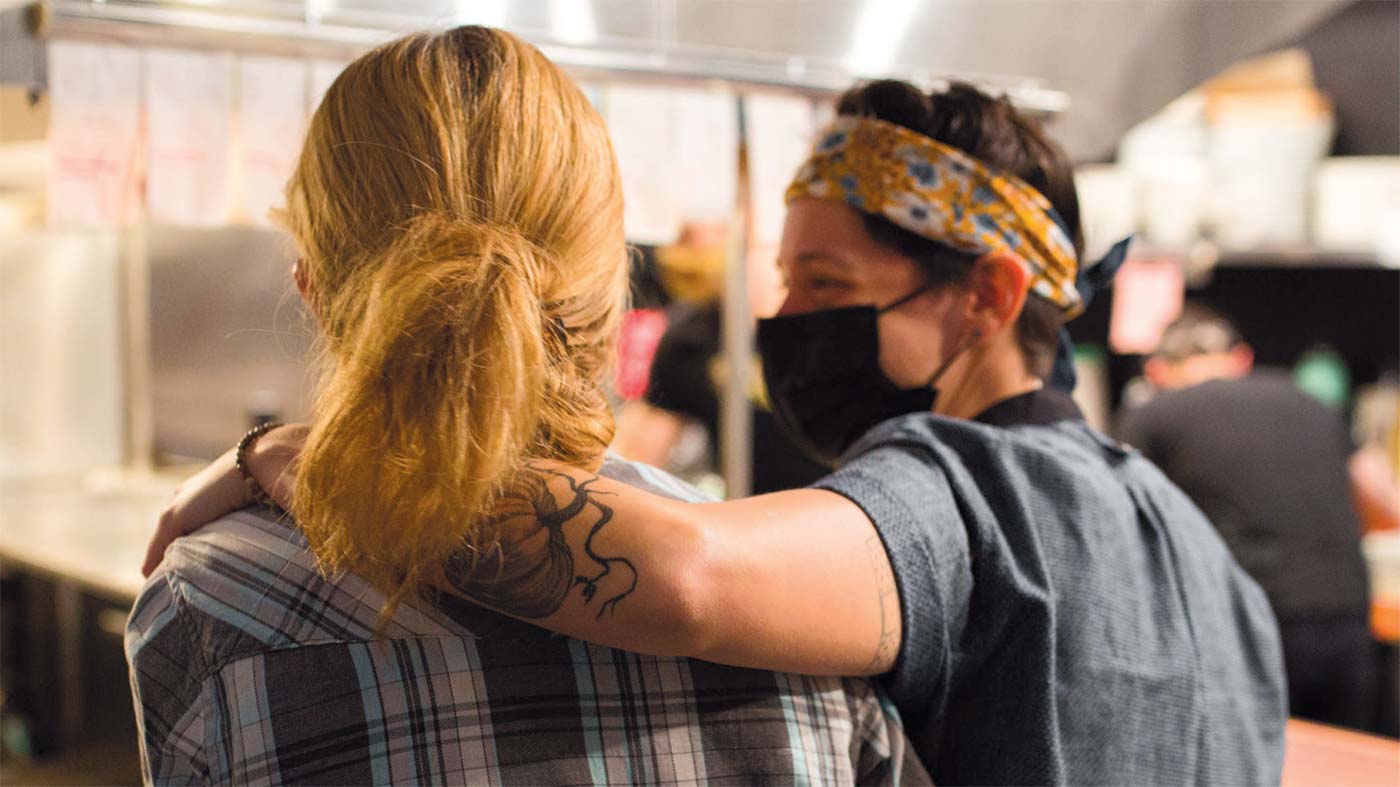
Oyster Club is well known for its classics like chowder and mussels. But it seems people are already excited about the items and additions that Renee and her team have introduced, including the new charcuterie. “That's always featured on the menu in some way because it's kind of like, ‘Oh, wow, I've never seen this before. What is this? Let me try that’. It’s great we're starting to get more people that are becoming adventurous eaters. So that's been really exciting and also working more with raw fish for ceviche's or crudos and things along those lines.”
Renee, as you might anticipate, is also a big fan of gathering local ingredients herself. “I love getting in the woods and foraging. I love being able to go to an oyster farm, a seaweed farm, and crabbing. I'm hoping to get out on a boat soon and go fishing for tuna. In fact, I was just out in the woods with my friend Corey from Nana’s Bakery, we're all friends here in this community. We hang out and talk food. We went into the woods recently and we were lucky to find some Hen of the Woods and that's always very exciting, also got some Chickens (both mushrooms) the other day too. All that stuff is good.”
Clearly, as a chef and a human, Renee appreciates the community that surrounds her. “Mystic is the new New York, it’s really a great place to be because we are surrounded by all this opportunity. I love that there's delicious bread and there's Moromi, where we go learn about Koji and soy sauce. There's Mystic cheese and there's a full mushroom farm at Seacoast Mushrooms, like right here. There's all these incredible places of knowledge and passion that surround us. I'm extremely happy to be able to work with all of these people and that's what makes our food delicious. It’s all these incredible people that work so hard in their own craft.”
- Oyster Club is located at 13 Water Street in Mystic. Visit www.oysterclubct.com for information about upcoming dinners including Jacques Pepin and Suzie Flores from Stonington Kelp.
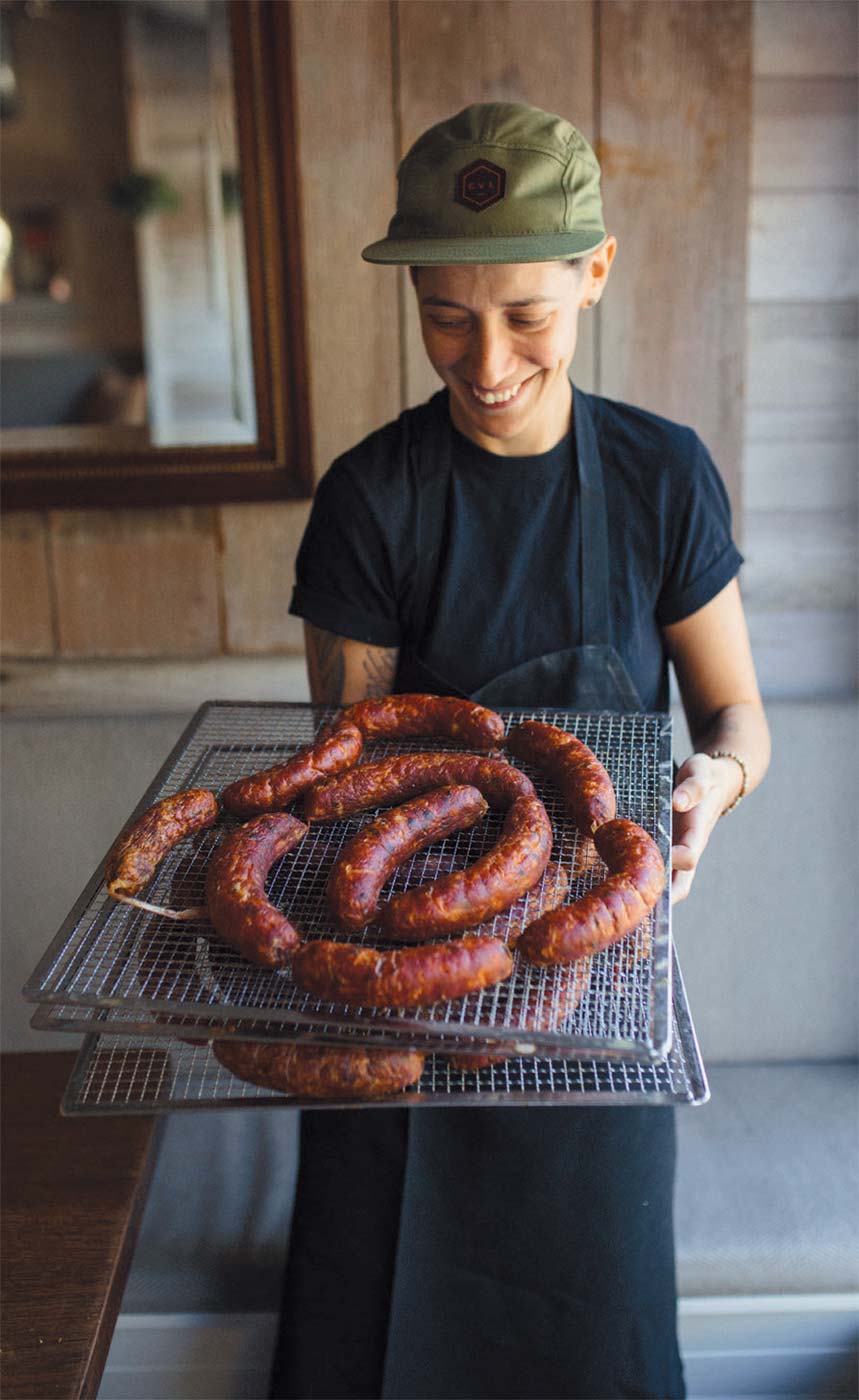
MAKING TUNA CHORIZO
Making the tuna chorizo may sound a little complicated. But the tuna recipe that we use is pretty straightforward. When we butcher a whole tuna, we take any of the scraps from the scrapings of the bones or the tail end or just the odds and ends. We take all of that scrap and then freeze it. With frozen fish, you can put it through a grinder in the same way you would make sausage using pork, you freeze it and then you grind it.
We then add pork fat with that lean meat from the fish. We whip it the same way you would making chorizo and add smoked paprika, paprika peppers that we've preserved from the summer, some red wine and added herbs. Then we encase it and we either poach it or bake it or grill it the same way you would do any other sausage. Or we may just let it ferment and hang out at room temperature. With that method it’s spreadable on top of bread or whatever you choose.
If we ferment it, we take that and we cure it or we just let it dry, hang it and let it dry. And then from that point after it dries, we take it and grate it over pastas or grate it over vegetables, or you can dice it and cook it with beans and things along those lines.


